|
Tamil
Edumban Temple
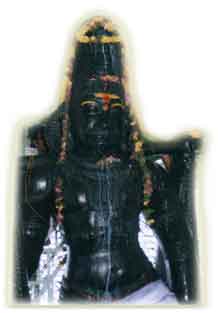
Palani,
Kavadi and Idumban
How Murugan, Idubam and Kavadi came to Palani.
Sage Agastya
wanted to take two hills -- Sivagiri and Saktigiri -- to his abode
in the South and commissioned his asuran disciple Idumban to carry
them. Idumban was one of the very few asuran survivors of the suraasuran
war between Murugan's forces and those of Surapadman. After surviving
the war he had repented and became a devotee of Lord Murugan.
Ganapati employs cunning to cheat Murugan Idumban finds the kavadi
is too heavy at Palani At this stage, Subrahmanya or Muruga had
just been outwitted by His brother Ganesa in a contest for going
around the world and He was still smarting over the matter. Ganapati
had won the prized fruit (the Jnana-pazham) by simply going around
His parents. Long after this, Subrahmanya came seating on His peacock
to find that the prize had already been given away. In anger, He
vowed to leave His home and family and came down to Tiru Avinankudi
at the Adivaaram (meaning 'foot of the Sivagiri Hill'). Siva pacified
Him by saying that Subrahmanya Himself was the fruit (pazham) of
all wisdom and knowledge. Hence the place was called Pazham-nee
('You are the fruit') or Palani. Later He withdrew to the hill and
settled there as a recluse in peace and solitude.
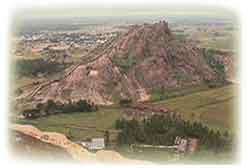 Idumban
bore the hills slung across his shoulders in the form of a kavadi,
one on each side. When he reached Palani and felt fatigued, he placed
the kavadi down to take rest. Idumban
bore the hills slung across his shoulders in the form of a kavadi,
one on each side. When he reached Palani and felt fatigued, he placed
the kavadi down to take rest.
Palani, the timeless centre of Murugan devotion When Idumban resumed
his journey, he found that he could not lift the hill. Muruga had
made it impossible for Idumban to carry it. Upon the hilltop the
great asuran spotted a little boy wearing only kaupeenam and demanded
that he vacate at once so Idumban could proceed with his task. The
boy, who was yet in a fighting mood, refused. In the fierce battle
which ensued, Idumban was slain but was later restored to life.
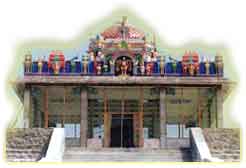 Idumban
belatedly recognised the boy as none other than his ista devata
Murugan and prayed to Him that: Idumban
belatedly recognised the boy as none other than his ista devata
Murugan and prayed to Him that:
1) whosoever
carried on his shoulders the kavadi, signifying the two hills and
visited the temple on a vow should be blessed; and 2) he should
be given the priviledge of standing sentinel at the entrance to
the hill. Hence we have the Idumban shrine half-way up the hill
where every pilgrim is expected to offer obeisance to Idumban before
entering the temple of Dandayudhapani Swami. Since then, pilgrims
to Palani bring their offerings on their shoulders in a kavadi.
The custom has spread from Palani to all Muruga shrines.
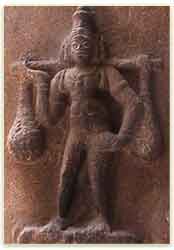
Muruga, in His aspect as Lord Dandayudhapani, stands for tyaagam
or renunciation. Eschewing all wordly possessions, the only apparel
He has chosen to retain is a loincloth called kaupeenam. But His
bhaktars never tire of offering Him costly garments and enriching
His wardrobe with luxurious royal clothes which are used to adorn
Him when His devotees yearn to see the Lord in the vesture of a
King. For indeed, His state is that of a Swami or sovereign Lord.
back
| 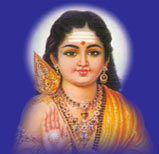


 Idumban
bore the hills slung across his shoulders in the form of a kavadi,
one on each side. When he reached Palani and felt fatigued, he placed
the kavadi down to take rest.
Idumban
bore the hills slung across his shoulders in the form of a kavadi,
one on each side. When he reached Palani and felt fatigued, he placed
the kavadi down to take rest.  Idumban
belatedly recognised the boy as none other than his ista devata
Murugan and prayed to Him that:
Idumban
belatedly recognised the boy as none other than his ista devata
Murugan and prayed to Him that: 